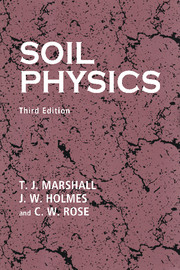Book contents
- Frontmatter
- Contents
- Preface
- Preface to the second edition
- Preface to the first edition
- 1 Composition of soil
- 2 Interaction of soil and water
- 3 Measurement of water content and potential
- 4 Principles of water movement in soil
- 5 Distribution of water in soil
- 6 Ground water in soils and aquifers
- 7 The use of isotopes and other tracers in soil water and groundwater studies
- 8 Soil structure
- 9 Deformation of soil
- 10 Management of soil water
- 11 Soil erosion and conservation
- 12 Chemical transport in soil
- 13 The physical environment of roots
- 14 Plants and soil water
- Appendixes
- References
- Index
7 - The use of isotopes and other tracers in soil water and groundwater studies
Published online by Cambridge University Press: 05 June 2012
- Frontmatter
- Contents
- Preface
- Preface to the second edition
- Preface to the first edition
- 1 Composition of soil
- 2 Interaction of soil and water
- 3 Measurement of water content and potential
- 4 Principles of water movement in soil
- 5 Distribution of water in soil
- 6 Ground water in soils and aquifers
- 7 The use of isotopes and other tracers in soil water and groundwater studies
- 8 Soil structure
- 9 Deformation of soil
- 10 Management of soil water
- 11 Soil erosion and conservation
- 12 Chemical transport in soil
- 13 The physical environment of roots
- 14 Plants and soil water
- Appendixes
- References
- Index
Summary
Field investigations of the subsurface of a catchment or watershed may be undertaken by methods such as those whose principles have been described in Chapters 5 and 6. Sometimes the pattern of sub-surface flow may be difficult to discover or to interpret by conventional hydrological experiments. Tracing techniques then offer an alternative that can be less costly in effort in the field and can provide results that would be unattainable by other methods.
There are two kinds of tracers. First, there are those that are injected into the aquifer or soil water for the purpose of the experiment. They must be carried with the water which is to be traced and must be capable of being recovered after a reasonable time. The altered concentrations, as measured, should be capable of hydrological interpretation and so the recovery grid of bore-holes should be designed with some existing knowledge of the hydrological system for guidance. The second kind of tracers are those that are not added artificially, but occur naturally as a peculiar feature of the hydrological cycle. There are a number of such environmental tracers, whose concentrations vary and can provide the data for hydrological enquiry. Chloride dissolved in rainwater is an example. It is carried into the soil by soil water infiltration and remains there or in groundwater in concentrations that are greatly increased at locations where most of the water is abstracted from the soil by the process of evapotranspiration.
- Type
- Chapter
- Information
- Soil Physics , pp. 172 - 198Publisher: Cambridge University PressPrint publication year: 1996
- 1
- Cited by



